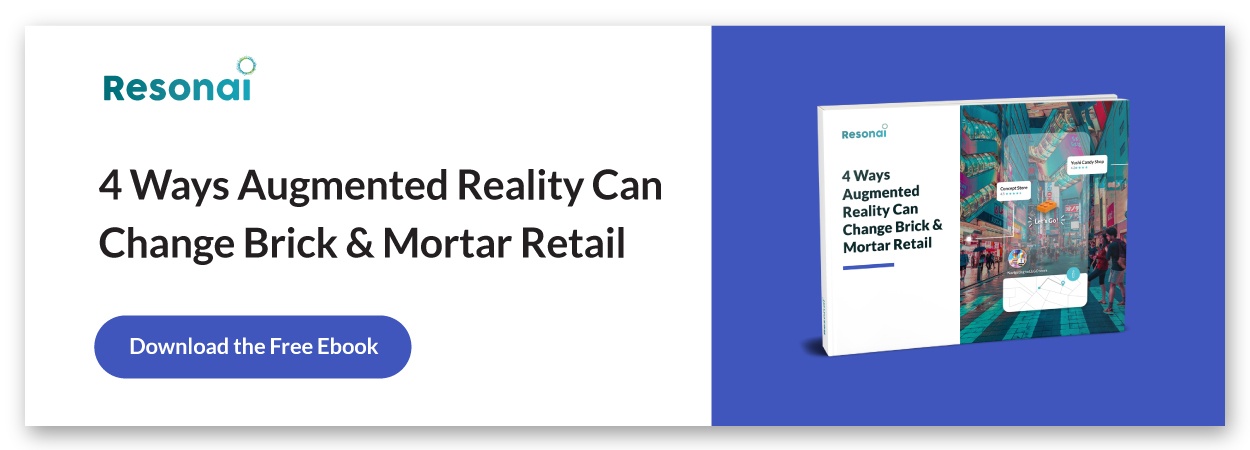What is Visual Merchandising?
Retailers need techniques that will attract and sustain customer attention. What is visual merchandising, and how can it achieve this goal?
.jpg?width=720&name=mockups_retail_7%20(1).jpg)
The average retail customer’s attention is often pulled in several directions, from physical storefronts to e-commerce websites, to subscription services. Many businesses turn to visual merchandising techniques to attract and sustain customer attention in competitive markets. But what is visual merchandising, and how can you implement it?
This article will define visual merchandising, present some physical and digital examples, and highlight the best practices retailers should follow. It will also briefly discuss AR visual merchandising applications that will become more common in the immediate future.
Need to brush up on the fundamentals of visual merchandising? Check out Visual Merchandising: The Complete Guide For Modern Retail.
Jump to a section…
Why is visual merchandising important?
What are the types of visual merchandising?
E-commerce and in-app storefronts
What are some best practices for visual merchandising?
Let color communicate intuitive details
Use signage to highlight product details and value
Add focal points to any visual display
Group products that will be together
The future of visual merchandising
What is visual merchandising?
Visual merchandising is the process of presenting products and services in the most optimal and visually engaging way. The goal for retailers is to display their wares so that customers will understand the appeal in a glance, ultimately driving a future purchase.
The history of visual merchandising mirrors that of the retail industry. The first department stores and retailers needed ways to attract customers to their locations as an alternative to public markets. Window displays were the most straightforward option — and earliest examples of visual merchandising — but brand owners quickly experimented with in-store product displays to enhance the customer experience.
Visual merchandising is a common sight in traditional brick-and-mortar retail stores, but the principle increasingly applies to any environment where sales occur — even digital. For example, many businesses adapt these techniques to fit e-commerce websites, in-app storefronts, and online marketing campaigns.
Why is visual merchandising important?
Visual merchandising is immensely beneficial for any seller of products and services. Businesses that successfully adopt these practices tend to attract more customers, drive additional sales, and gain a higher value from products.
Visual merchandising makes retail spaces more attractive and engaging to visiting customers. By presenting brands or products in this context, customers tend to feel more confident in purchasing decisions — for example, seeing a bed on display communicates more details about how it looks in a space than photographs. Visual merchandising techniques can also act as extensions of a brand, reflecting and enhancing marketing efforts.
Perhaps most importantly, visual merchandising creates a shopping experience that feels like more than a simple transaction. Leveraging these techniques effectively contributes to brand loyalty and differentiates businesses from their competition.
What are the types of visual merchandising?

Display windows
One of the earliest forms of visual merchandising, display windows, catches passersby’s attention while letting them know what kind of goods to expect once they enter. Display windows typically highlight new stock and current deals to maximize customer interest.
Interior displays
If a display window is a shout, an interior display is an intimate conversation. They can be much smaller than their cousins in the front windows, speaking to the specific needs of a shopper. These range from glass cases holding valuable items, mannequins wearing new fashions, and anything in-between.
Point-of-purchase displays
When retailers intentionally place inexpensive items at checkout counters, customers already making a purchase are more likely to buy them. Point-of-purchase displays might include magazines, candy, chewing gum, and similar products. Some retailers will also have “deal of the day” signage to highlight last-minute promotions.
Seasonal displays
Part of visual merchandising displays’ appeal is that they’re dynamic, which creates opportunities for showcasing seasonal products. Christmas, Valentine’s Day, or even back-to-school displays can highlight specific products that customers need within particular timeframes.
Category displays
One familiar visual merchandising technique is to group similar products. The most recognizable example is grocery stores, which arrange food items in visually distinct categories. Packaged goods are on standard aisles, fresh vegetables sit in the open, and deli meats are behind display glass.
E-commerce and in-app storefronts
Technology is driving many advancements in visual merchandising, but it also lets us apply these techniques out-of-store more effectively. An Amazon product listing that lets users look at screenshots is a form of visual merchandising, even if it breaks traditional retail practices. Category listings and similar product links also apply to an e-commerce environment. Finally, in-app storefronts give brands a high degree of control over the shopping experience customers will see upon installing an app.
Interactive displays
Interactive displays that draw customers into the shopping experience are the next frontier of visual merchandising. These displays can take many forms, from in-store screens that showcase items, to AR apps that demonstrate what products look like within a given space.

What are some best practices for visual merchandising?
Whether you are designing a display window or an interactive touchscreen, the same visual techniques can help your display stand out. While you may need to adapt techniques to suit a particular medium, a consistent tone across all displays will help customers feel familiar with your brand as they explore your products.
Let there be light
Using appropriate lighting is crucial to closing a deal, with one retailer seeing 12% additional sales after updating their fixtures. Diffuse light distribution helps customers feel more comfortable navigating a store, while high contrast lighting makes product details more visible to observers. Spotlights and additional lamps within display cases are also great ways to highlight products.
Let color communicate intuitive details
Color is one of the most effective ways to communicate subtle details about a brand or product. Blue, for example, tends to evoke calm feelings while red generates passion and excitement. Colors can also evoke associations with specific ideas, such as green with environmentally-friendly products.
Effectively-chosen colors can also attract customer focus. A color frame surrounding a product can highlight details in ways a standard visual cannot. Alternatively, contrasting a brightly colored product with darker surroundings — or vice versa — can draw customers’ eyes. Be sure to experiment to find the right combination for your product and brand.
Use signage to highlight product details and value
While many visual merchandising cues rely on customer intuition, sometimes there’s just no beating a well-placed sign. Retailers may place promotional stickers on objects or hang banners during a seasonal sale. Digital interfaces can also place buttons in locations that customers can interact with for additional information. While brands should use signage sparingly — it’s always better to show than tell — key bullet points that communicate product value will go a long way towards completing a sale.
Add focal points to any visual display
One essential visual merchandising technique is to create focal points that direct customer attention. Spotlights and signage can contribute to this goal, but brands must consider it more generally as well. Avoid overstuffing product displays with merchandise that will take attention away from each product. Make use of empty space to draw the eye, whether in your marketing or in-store surroundings. If your visual merchandising can guide customers to related products or checkouts without explicit directions, you’re on the right track.
Group products that are useful together
Grouping products by category is a common practice, but you can go a step further by linking products that go together. Most grocery stores will include potato chips and dip selections in the same aisle, even though they represent different categories. A web page selling video game consoles will feature links to the most popular games for each system. Think about what products fit together and group them accordingly, instead of leaving the customer to hunt them down.
The future of visual merchandising
In 2021 and beyond, brands will find new ways to leverage technology in retail environments, just like e-commerce and interactive displays. One powerful example is augmented reality, which can present authentic digital representations of products in a physical space.
AR in visual merchandising is relatively new in retail but already shows immense potential:
- AR makes it possible to render 1:1 digital representations of products, complete with custom features, materials, and color schemes.
- Retailers can offer product demonstrations to customers both in-store or at home.
- Unlike traditional displays, AR presentations have “unlimited” floor space to render products that are unavailable or difficult to display.
- AR lets retailers make simple audiovisual adjustments on the fly, such as changing lighting or product colors.
Whether you are developing a traditional display or considering AR-powered designs, the key to visual merchandising is emphasizing the buyer experience. By guiding customers through the buyer’s journey through visual cues, you can create an immersive event that meets their needs and helps them trust your brand.
Want to know more about incorporating AR into your visual merchandising strategy? Get in touch with Resonai today and set up a free demonstration, or click the button below to download our free eBook on the power of AR in retail.
Subscribe to Our Newsletter!
Read More
5 Top Startups in Israel to Watch in 2022
Anyone researching new businesses will quickly realize that Israel is the startup capital of the...
Retail Foot Traffic: The Essential Guide
In the ever-shifting retail landscape, maintaining an optimized business strategy requires insight...
How to Get the Most Out of Smart Building Upgrades
Building management is a costly, time-consuming endeavor. With routine maintenance, tenant...

